blinded sphinx
(Paonias excaecata)
Conservation • Description • Habitat • Ecology • Distribution • Taxonomy
|
||||||||
| Hodges # | 7824 |
|||||||
Conservation Status |
||||||||
| IUCN Red List | not listed |
|||||||
| NatureServe | N5 - Secure SNR - Unranked |
|||||||
| Minnesota | not listed |
|||||||
Description |
||
Blinded sphinx is a large to very large sphinx moth. It occurs across the United States and southern Canada. It is common in Minnesota. Adults are found from mid-June through mid-July in open deciduous forests and woodlands, woodland edges and clearings, and shrubby areas. Larva feed on a wide variety of deciduous trees and shrubs. The adult is 1⅜″ to 2″ (35 to 50 mm) long and has a wingspan of 2 3⁄16″ to 3⅞″ (55 to 95 mm). The body is heavy, long, and tapered. The antennae are thread-like, thickened, and somewhat spindle-shaped at the tip. The mouthparts are reduced. Adults do not feed. The forewings are long and narrow with several lines and several shades of brown. The leading (costal) margin is convex near the wingtip, and the inner margin is concave near the end, giving the wing a curved appearance. The outer margin is strongly scalloped. The fringe is white. The median area is dark brown and tinted violet. The subterminal area is dark and sometimes tinted greenish. There is a thick black bar in the upper median area that connects to the antemedial (AM) line. The discal spot is a black dot. The hindwing is pink and has a large blue eyespot ringed with black. The eyespot does not have a small black spot (pupil) in the middle. This is the feature that gives the moth its common name. The larva (caterpillar) is up to 3″ (7.5 cm) long. It is usually bright green, sometimes yellowish-green or bluish-green. The head, thorax, and abdomen are moderately covered with prominent, minute, white bumps. The head is broadly triangular, flattened, and framed with a thin pale line. A long, straight, horn extends at a 45° angle from the eighth abdominal segment. The horn is green with no blue. There is a pale subdorsal stripe on the thorax, and a bold whitish diagonal line that extends from the horn to just above the leg-like structure (proleg) on the sixth abdominal segment. Abdominal segments 1 through 6 each have a lateral, yellowish, diagonal line and small black circle surrounding the white respiratory opening (spiracle). Sometimes there is a wine-red spot on each abdominal segment in the subdorsal area and in the spiracular and/or subspiracular area. Mature caterpillars can be found from from May through November. |
||
Size |
||
Total length: 1⅜″ to 2″ (35 to 50 mm) Wingspan: 2 3⁄16″ to 3⅞″ (55 to 95 mm) |
||
Similar Species |
||
Habitat |
||
Deciduous forests and woodlands, woodland edges and clearings, and shrubby areas |
||
Ecology |
||
Season |
||
One generation per year in Minnesota: Mid-June through mid-July |
||
Behavior |
||
Adults are active at night and are attracted to light. When perched, the wings are held elevated, slightly away from the body, and parallel to the resting surface. |
||
Life Cycle |
||
Pupae overwinter |
||
Larva Hosts |
||
Leaves of a wide variety of deciduous trees and shrubs |
||
Adult Food |
||
Adults do not feed. |
||
Distribution |
||||
|
Sources |
|||
| 7/1/2023 | ||||
Occurrence |
||||
Common |
||||
Taxonomy |
|||
Order |
Lepidoptera (Butterflies and Moths) | ||
Superfamily |
Bombycoidea (Hawk, Sphinx, Silk, Emperor, and Allied Moths) | ||
Family |
Sphingidae (sphinx moths) | ||
Subfamily |
Smerinthinae | ||
Tribe |
Smerinthini | ||
Genus |
Paonias | ||
Synonyms |
|||
Paonias excaecatus |
|||
Common Names |
|||
blind-eyed sphinx blinded sphinx (larva) blinded sphinx moth (adult) |
|||
Glossary
Costal margin
The leading edge of the forewing of insects.
Proleg
A fleshy structure on the abdomen of some insect larvae that functions as a leg, but lacks the five segments of a true insect leg.
Spiracle
A small opening on the surface of an insect or arachnid through which it breathes.
Visitor Photos |
|||||
Share your photo of this insect. |
|||||
| This button not working for you? Simply email us at info@MinnesotaSeasons.com. Attach one or more photos and, if you like, a caption. |
|||||
Lisa Schirmers |
|||||
I thought it was an old dry maple leaf as we have very mature trees, and it was on my deck table. Was going to pick it off and it startled me because it was soft! I very gently looked at it with a dry maple tree seed and it was alive and was not in distress. I came out to put water out for the birds, so I thought it would be gone by morning. It’s shifted position but it was still there today. Doesn’t appear injured. |
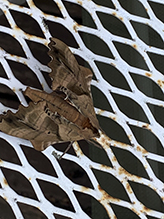 |
||||
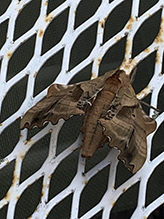 |
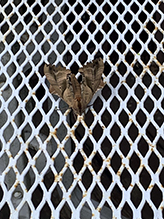 |
||||
Samuellner |
|||||
resting on back steps near dusk |
|||||
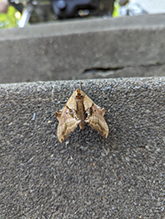 |
|||||
Lucy Morrissey |
|||||
On a crabapple tree at dusk |
|||||
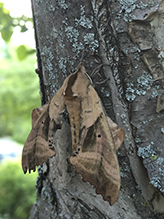 |
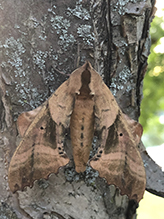 |
||||
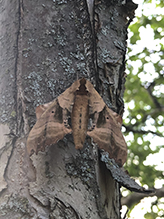 |
|||||
Luciearl |
|||||
Interesting how it would look like a bat to the fence wire. |
|||||
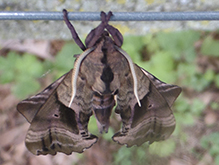 |
|||||
MinnesotaSeasons.com Photos |
|||||
|
|||||

Slideshows |
||

Visitor Videos |
|||
Share your video of this insect. |
|||
| This button not working for you? Simply email us at info@MinnesotaSeasons.com. Attach a video, a YouTube link, or a cloud storage link. |
|||
Other Videos |
|||
| Blinded Sphinx (Paonias excaecata) Lateral Close-up Carl Barrentine |
|||
About
Jul 13, 2013 A lateral close-up look at the Blinded Sphinx Moth (Paonias excaecata). Photographed at the Turtle River State Park, North Dakota (12 July 2013). |
|||
| Blind-eyed Sphinx Moth (Sphingidae: Paonias excaecata) on Screen Carl Barrentine |
|||
About
Jun 16, 2011 Photographed at Fisher, Minnesota (16 June 2011). |
|||
| blinded sphinx moth | paonias excaecata The Mothologist |
|||
About
Jul 28, 2019 |
|||
| Amazing Moth that Looks Like Brown Leaf - Paonias excaecata Tony Lee Glenn |
|||
About
Sep 11, 2014 Don't know if I've identified this moth correctly. Is it Paonias excaecata? I had entomology in college - but it's been a long long time ago. Just thought this one was pretty extraordinary! Is it the moth on this web page?: https://bugguide.net/node/view/61053/bgimage |
|||


Created: 9/30/2020
Last Updated:




